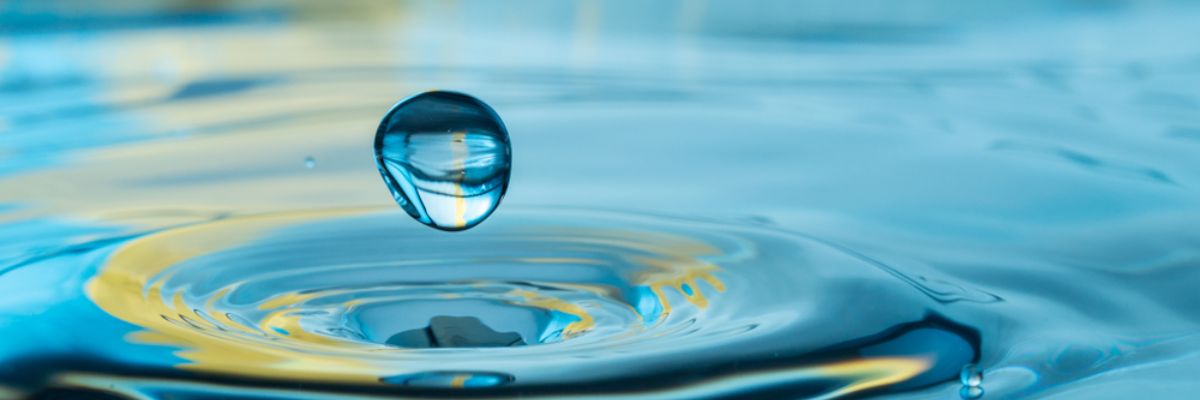
Hydrochemist Martin Pivokonský on how to improve water and wastewater treatment
22. 03. 2024
World Water Day is held on 22 March, declared by the UN in 1993 to remind us of the importance of this liquid substance vital for our entire planet. Saying that life on Earth wouldn’t exist without it may be a cliché, but it’s true. Water has been a constant companion of Martin Pivokonský from the Institute of Hydrodynamics of the CAS all his professional life. Is there anything new left to be learned about water? The article below was originally published in Czech in the quarterly A / Magazine of the CAS.
A life-giving liquid. It can be cool, warm, sweet, salty, tap, spring, rain, ground, mineral, but also stagnant, polluted, sometimes even toxic. Some of these modifiers probably could not be used for any other one single word. The chemical compound has the formula H2O and the systematic name oxidane, but we all know it by its common name: water. To make sure we can associate it as much as possible with its positive attributes, we need to look after it properly. One of the most qualified individuals that’s in the know about all things water is hydrochemist Martin Pivokonský, director of the Institute of Hydrodynamics at the Czech Academy of Sciences (CAS).
Although his surname evokes another liquid, a beverage that is very popular among the Czechs, it is water which Pivokonský has devoted his career to. As he himself says, his personal relationship to water is not very particular, but neither is it very positive: “The first thing that comes to mind when I think of water is: wet and cold. I don’t really like getting wet, but I feel like I get wet all the time, for instance, whenever I find myself cycling or hiking.” Despite this, water has been a staple of his life for a long time – the researcher has been dedicated to it since his university studies, and his professional relationship to it is very positive.
From monitoring to testing
To begin with, it is important to clarify two terms that people sometimes do not distinguish – water treatment and wastewater treatment. Water treatment is the process of turning raw water (surface water or groundwater) into potable water. This is done in water treatment plants. On the other hand, the treatment of wastewater from households, industry, and agriculture takes place in wastewater (or sewage) treatment plants. The treated water is then returned to the water cycle or can be reused – but is not fit for human consumption.
His research concentrated mainly on water treatment, but more recently also on wastewater treatment, is also linked to the Academic Award, or Praemium Academiae (bestowed by the CAS), which Pivokonský received in 2022. With his research team, he focuses on describing and monitoring the occurrence of the composition of contaminants found in water sources, such as natural organic substances and anthropogenic micropollutants, i.e., those originating from human activities. The researcher is also seeking to shed light on their physical and physical-chemical properties that play a role in their removal from water. He is interested in their interactions with each other and with chemical agents used in water purification and treatment.
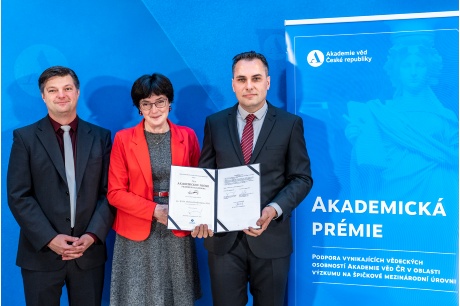
In 2022, Martin Pivokonský (right) received the prestigious Praemium Academiae – Academic Award.
The research focus of the thirteen-member team is broad in scope. The team is also involved in developing new water treatment methods such as oxidation and photo-oxidation technologies, electrocoagulation, and secondary coagulation that precedes membrane filtration. “In addition, we’re also working on laboratory and pilot-scale testing of new methods and technologies for water treatment and wastewater treatment. In other words, we are interested in the occurrence of pollutants in water, their interactions, and toxicological effects, all with the aim of developing new effective methods for their removal,” Pivokonský specifies.
In order for researchers to be able to fully dedicate themselves to all these areas, they need good conditions for their work. “In the Czech Republic, it’s not so much a lack of equipment or insufficient infrastructure that troubles us. The problem lies in the long-term undervaluation of the financial remuneration for highly qualified workers,” the researcher explains, whose vision of how to make use of the generous financial bonus that comes with the Praemium Academiae is clear – invest in people. He plans to create a strong team of experts that will remain functional even after the financial resources from the awarded bonus have been depleted.
Logically, this leads to the fact that scientists are constantly writing projects in order to have enough money to run their institutions, and they have less and less time for their own science. "Until institutional support is increased to at least eighty percent, there will be no stabilisation of Czech science," Pivokonský believes.
Just as clear-cut as his vision of a robust research team is his stance on supporting science in the Czech Republic. According to him, the fundamental shortcoming is the fact that institutional funding is lacking, greatly: “Lacking to such a degree, in fact, that without earmarked funding, we wouldn’t even have enough money for the day-to-day operation of our institutions, let alone any serious research.” Logically, this leads to scientists constantly submitting various grant projects just to obtain enough funds for operation, leaving them with less and less time for actual scientific work. “Until institutional support is increased to at least eighty percent, there can be no talk about stabilising Czech research and development,” Pivokonský believes.
The most valuable natural resource
Although water covers up to three-quarters of our planet, it is becoming increasingly scarce. It is reported that freshwater constitutes only two-and-a-half percent of the total volume of water. However, this does not necessarily mean that it is potable or usable for industry, agriculture, and other sectors of human activity. Around the world, water sources are contaminated by a variety of anthropogenic substances. These include various industrial chemicals, flame retardants, detergents, pharmaceuticals, veterinary drugs, pesticides and their metabolites, components of cosmetic and household products, artificial sweeteners and dyes, heavy metals, and organometallic compounds.
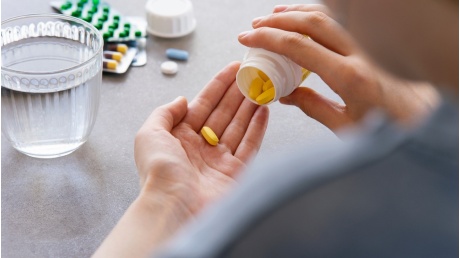
Water around the world is contaminated by a number of anthropogenic substances, including pharmaceuticals.
Unfortunately, they usually pose certain toxicological risks: often, these are substances with chronic health effects, even though they occur in water sources at concentrations in the order of “mere” nanograms per litre (ng/l), or micrograms per litre (μg/l). To illustrate, it’s as if we were trying to account for a one-hundred-crown bill in the state budget of the Czech Republic.
“If we take into account, in addition to anthropogenic pollutants, naturally occurring pollutants such as aluminosilicates, humic substances resulting from the decomposition of plant residues, and substances produced by cyanobacteria, water sources today are a mixture of heterogenous substances with complex mutual interactions and difficult-to-define treatment conditions. In this context, it is apt to speak of a ‘cocktail of substances,’” the hydrochemist explains.
Because in the past, water treatment primarily focused on the removal of common natural substances, it is them that current scientific knowledge and technological procedures are aimed at. However, the present-day cocktail of natural and anthropogenic pollutants requires new, focused research, not only to monitor their occurrence, but also to elucidate their hydrochemical role and develop new technological methods for their removal.
“There is an unimaginable amount of substances potentially contaminating our waters, and oftentimes, we don’t even know how much so, because we simply aren’t assessing them. What’s more, many times we don’t even know what these substances are,” Pivokonský explains, pointing out the fact that it is high time to reconsider whether we are assessing the quality of water today according to the right indicators. It is evident that while water sources show better quality in terms of “traditional” indicators than, for instance, at the beginning of the millennium, in terms of “new” pollutants, this may not be the case, or may show even worse results.
Where there’s danger lurking
Every day, we use an incredible amount of chemical substances that ultimately end up back in our environment. And because water is an ideal transport medium for many substances, they eventually make their way into water sources, too, even if their life cycle may not directly involve water. A typical example is the widely discussed perfluorinated organic compounds (PFAS). What are they, exactly?
“Perfluorinated and polyfluorinated organic compounds represent an extensive group of several thousand human-made organic compounds characterised by a very strong bond between fluorine atoms and carbon atoms rather than hydrogen atoms. While this gives them unique properties useful in industrial production, they are literally a disaster for the environment,” the researcher explains. The bond between carbon and fluorine does not occur naturally in the natural environment, so there are no natural mechanisms in place to break down these substances.
These substances are therefore persistent (resistant to degradation) and bioaccumulative (accumulating in living organisms). Moreover, they are considered human carcinogens. They are likely the cause of kidney, ovarian, testicular, and prostate cancer. They are also highly reprotoxic (reducing fertility in women), they can increase the risk of high blood pressure during pregnancy and cause pre-eclampsia (a placental disease) and lower birth weight in newborns.
Since PFASs have been manufactured since roughly the 1950s, they are now found everywhere in the world and in virtually all components of the environment, including water and food. “Their occurrence even in small quantities is, in my opinion, alarming. If we were to consider that the concentration of PFASs in water is, say, even just twenty nanograms per liter, and you drink and consume an average of four liters of water per day, your daily intake is eighty nanograms. This is a significant amount, and this is taking into consideration the intake from drinking water alone,” Pivokonský points out.
Beware of cosmetics
When the life cycle of the chemicals used is directly dependent on water, unlike PFASs, contamination of water sources can be significant, without us even realizing it. Pivokonský provides an example: “A recent study analysed the amount of chemicals released by dishwasher tablets. It found that more than three-and-a-half thousand different chemical substances are released from a single tablet.” These then enter wastewater and subsequently into water recipients, i.e., places where surface water and wastewater converge, such as ponds, reservoirs, lakes, and watercourses.
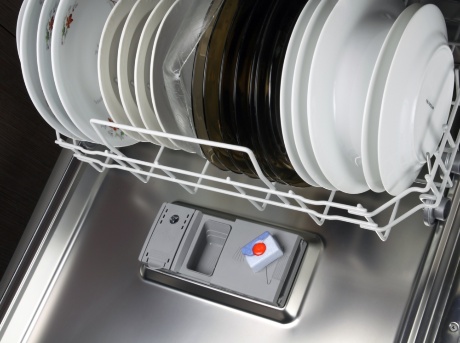
A recent study showed that more than three and a half thousand different chemicals are released from dishwasher tablets.
However, dishwasher tablets are not the only concern. While drugs and hormones are relatively well broken down by natural processes, due to their overall high daily consumption in society, we find them in practically every water source. According to Pivokonský, what gets somewhat overlooked in discussions are so-called personal care products. A typical representative of this group of substances is, for instance, triclosan, which has antibacterial and fungicidal effects. It gets added to soaps, deodorants, toothpaste, shaving cream, mouthwash, and cleaning agents. However, it is also found in kitchen utensils, toys, bed linen, and garbage bags. Its effects on human health are debated; nevertheless, it appears to be a substance that affects the endocrine system, specifically the thyroid gland.
Pivokonský emphasises that the problem is not so much the concentration of individual substances but rather their overall mix and synergistic effect on living organisms: “Sometimes I am truly astounded by the tired argument of certain technocrats that all the substances we analyse in water or other components of the environment have always been there and we just didn’t know it because we didn’t have the appropriate analytical capabilities. This is a complete fallacy! Anthropogenic substances can only have been present in water since we started producing them.”
According to the researcher, another dangerous misconception is the claim that water is devoid of these substances or that their concentrations are so low that they are not worth paying attention to. Today, we produce a huge amount of chemicals and use them so to such an extent that they are simply everywhere, including in the water. Hundreds, perhaps thousands or tens of thousands of chemical substances enter the water. “But how many of them do we actually assess? Dozens realistically, occasionally in some study, hundreds. However, this may only represent a fraction of the actual situation,” Pivokonský says. There are countless substances polluting our water. If we were to mention them all, it would make for a lengthy publication.
Protecting water sources, protecting our air, protecting agricultural land, protecting our seas and oceans, protecting biodiversity... We are already protecting the entire planet, yet our environment continues to deteriorate. How is this possible? Pivokonský wonders, answering himself straight away: “It’s probably because the sentiment sounds good on paper, but in reality, we’re not actually protecting much. We should stop hiding behind the protection of everything and admit that what we really care about is the protection of ourselves and our own human existence here and now. Then perhaps we could finally start living and managing things sensibly, thereby actually protecting everything mentioned above.”
Opposites attract
Some people are said to be like fire and water. In Pivokonský, both elements intertwine in one person. His lifelong passion is water, but as a Sagittarius, he falls under the fire signs in the zodiac. Sagittarians are said to excel in their idealism and sincerity, they yearn for truth and knowledge, and their lives tend to be active and adventurous. Freedom is important to them, and they do a lot to pursue what they believe in and enjoy. They are honest, straightforward, and at times can be accused of lacking tact.
“Personally, I don’t believe in astrology. However, I must admit that this characterisation actually fits me. I am very honest and straightforward, to the point where I often put people in awkward situations. Sometimes it can even cause me a bit of trouble because I always consider it best to say what I think, which is a mindset not everyone understands,” Pivokonský says. He also adds that he cannot do things he doesn’t believe in – and on the contrary, devoting himself to what he believes in is very enjoyable for him.
He considers freedom, both personal and professional, the greatest gift. He views science as one of the freest activities there is: “I once said that science is an aristocratic calling in the best sense of the word, meaning that it gives us tremendous freedom to explore what we ourselves deem important, but on the other hand, it imposes enormous demands on us considering that it is a service to society. In other words, it is essential for us to have the freedom in deciding the direction of our research, but at the same time, it must be an absolute given for every scientist that their research is public, transparent, and serves humanity as a whole.”
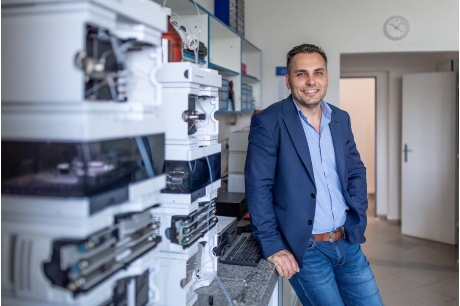
Martin Pivokonský (CC)
Assoc. Prof. RNDr. Martin Pivokonský, Ph.D.
Institute of Hydrodynamics at the Czech Academy of Sciences
Pivokonský has been the director of the Institute of Hydrodynamics of the CAS since 2017. He studied Environmental Studies at the Faculty of Science, Charles University in Prague, and subsequently pursued the field of Applied and Landscape Ecology. As an educator, he lectures on hydrochemistry, water pollution and protection, and the treatment of groundwater and surface water. He is the author of several utility models, patents, and over sixty publications in academic journals, and he has co-authored several books, such as Coagulation in Water Treatment and Jar Tests for Water Treatment Optimisation: How to Perform Jar Tests – a handbook. As a researcher, his primary focus is hydrochemistry, water treatment and purification, water protection, and other environmental issues related to water pollution. In 2021, he received the President's Award from the Czech Science Foundation, and a year later, he was awarded the prestigious Praemium Academiae by the Czech Academy of Sciences.
The story was publish in the 3/2023 Czech issue of the A / Magazine:
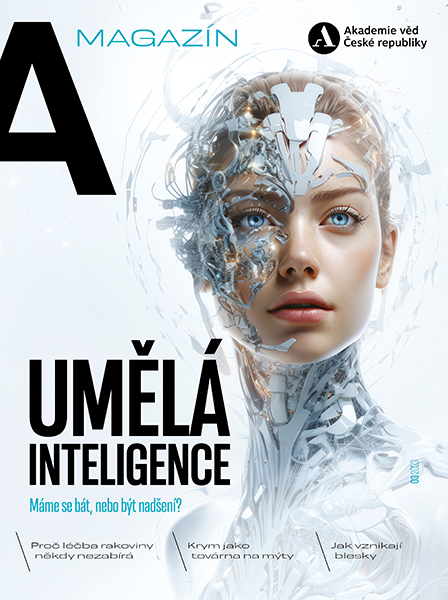
3/2023 (version for browsing)
3/2023 (version for download)
Prepared by: Markéta Wernerová, External Relations Division, CAO of the CAS
Translated by: Tereza Novická, External Relations Division, CAO of the CAS
Photo: Shutterstock; Jana Plavec, External Relations Division, CAO of the CAS
 The text and photos labelled (CC) are released for use under the Creative Commons licence.
The text and photos labelled (CC) are released for use under the Creative Commons licence.
Read also
- “Fat can be extracted even from thousand-year-old pottery,” says V. Brychová
- Evolution, alive and well. What lies at the heart of biodiversity?
- From an evolutionary POV, vision has a great benefit–cost ratio, researcher says
- Badminton buzz: Tournament draws 76 athletes from the Academy’s institutes
- Unique reproductive strategy confirmed in another frog species in Moravia
- Involved in groundbreaking research, Ukrainian archeologist now works at the CAS
- The first human presence in Europe securely dated to 1.4 million years ago
- The CAS visited by chess grandmaster and Russian opposition activist Kasparov
- The CAS will support scientists whose research is at risk in their home country
- Unravelling the mystery of biodiversity – with a little help from the fruit fly
The Czech Academy of Sciences (the CAS)
The mission of the CAS
The primary mission of the CAS is to conduct research in a broad spectrum of natural, technical and social sciences as well as humanities. This research aims to advance progress of scientific knowledge at the international level, considering, however, the specific needs of the Czech society and the national culture.
President of the CAS
Prof. Eva Zažímalová has started her second term of office in May 2021. She is a respected scientist, and a Professor of Plant Anatomy and Physiology.
She is also a part of GCSA of the EU.